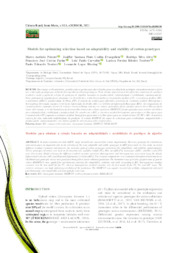Models for optimizing selection based on adaptability and stability of cotton genotypes.
Models for optimizing selection based on adaptability and stability of cotton genotypes.
Autoria: PEIXOTO, M. A.; EVANGELISTA, J. S. P. C.; ALVES, R. S.; FARIAS, F. J. C.; CARVALHO, L. P.; TEODORO, L. P. R.; TEODORO, P. E.; BHERING, L. L.
Resumo: In multi-environment trials (MET), large networks are assessed for results improvement. However, genotype by environment interaction plays an important role in the selection of the most adaptable and stable genotypes in MET framework. In this study, we tested different residual variances and measure the selection gain of cotton genotypes accounting for adaptability and stability, simultaneously. Twelve genotypes of cotton were bred in 10 environments, and fiber length (FL), fiber strength (FS), micronaire (MIC), and fiber yield (FY) were determined. Model selection for different residual variance structures (homogeneous and heterogeneous) was tested using the Akaike Information Criterion (AIC) and Bayesian Information Criterion (BIC). The variance components were estimated through restricted maximum likelihood and genotypic values were predicted through best linear unbiased prediction. The harmonic mean of relative performance of genetic values (HMRPGV) were applied for simultaneous selection for adaptability, stability, and yield. According to BIC heterogeneous residual variance was the best model fit for FY, whereas homogeneous residual variance was the best model fit for FL, FS, and MIC traits. The selective accuracy was high, indicating reliability of the prediction. The HMRPGV was capable to select for stability, adaptability and yield simultaneously, with remarkable selection gain for each trait.
Ano de publicação: 2021
Tipo de publicação: Artigo de periódico
Unidade: Embrapa Algodão
Observações
1 - Por padrão são exibidas publicações dos últimos 20 anos. Para encontrar publicações mais antigas, configure o filtro ano de publicação, colocando o ano a partir do qual você deseja encontrar publicações. O filtro está na coluna da esquerda na busca acima.
2 - Para ler algumas publicações da Embrapa (apenas as que estão em formato ePub), é necessário ter, no celular ou computador, um desses softwares gratuitos. Sistemas Android: Google Play Livros; IOS: iBooks; Windows e Linux: software Calibre.
Acesse outras publicações
Acesse a Base de Dados da Pesquisa Agropecuária (BDPA) para consultar o acervo completo das bibliotecas da Embrapa.

